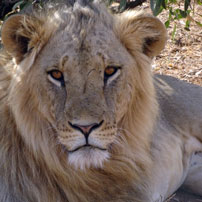
The end of June signalled a return to Kenya. This time to explore numerous regions that I missed on my previous trip with Michele. Again I flew out on the daylight British Airways flight and once I arrived into Nairobi, I made my way to the new airport hotel, Crowne Plaza Nairobi Airport (formerly Lazizi Premiere). Located inside the airport complex and approximately a five minute drive from the terminals, it provides a great location for an overnight stay either before an early flight or after a late arrival.
The next morning, I was greeted nice and early by the big smile of our Benroso Safaris driver, Jackson for my transfer to Wilson Airport where I connected with a morning light aircraft flight south to Amboseli National Park – as you near the Park, Mount Kilimanjaro comes into view. Making my way from the airstrip to Tortilis Camp, the guide spotted an outline of a cat slinking through the open between two thickets. As we got closer, we saw that is was an elusive caracal (!). This was only the second time that my guide had seen one in Amboseli. He had been there for the last six years – I had been there for around 10 minutes.
In the shadows of Mount Kilimanjaro, Amboseli has a very unusual landscape with natural swamps filled by the melting ice and snow from the mountain. These swamps attract large numbers of elephants, a species which Amboseli has become synonymous w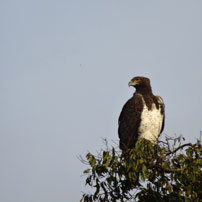 ith. Being a National Park, you do get self-drivers and minibuses, but the beauty of Tortilis Camp is their own private concession where they have exclusive traversing rights. Unfortunately, despite being so close to the mountain, I caught only a fleeting glimpse as the summit was in the clouds for the duration of my stay.
ith. Being a National Park, you do get self-drivers and minibuses, but the beauty of Tortilis Camp is their own private concession where they have exclusive traversing rights. Unfortunately, despite being so close to the mountain, I caught only a fleeting glimpse as the summit was in the clouds for the duration of my stay.
After one night in Amboseli, I flew north to Meru National Park (via Nairobi). Meru is beautiful and unlike the rest of Kenya that I have visited – it almost felt like being in Southern Africa. With large doum palm trees, euphorbias and thickly vegetated riverine areas, it had an almost tropical feel. Meru National Park is well known for once being a home for George Adamson and the famous Elsa the lioness, I stayed at the aptly name Elsa’s Kopje located just above Adamsons former campsite. With very limited accommodation options, you rarely see another vehicle on game drives and it allows you to in the wilderness. Wildlife was good, with healthy numbers of game as well some of the northern species including gerenuk and reticulated giraffe.
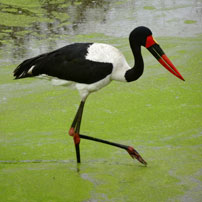
From Meru, I was driven northwards (for approx. 5 hours) through rural villages and towns of central Kenya and into the Northern Rangelands, through to the spectacular Mathews Range. After turning off the main tar road, we continued through the wilderness of the Namunyak Conservancy towards the slopes of the Mathews until we arrived at Sarara Camp. It has to be one of the most spectacular places I have been and it must have one of the best pool views in Africa. Sarara is not a top game viewing destination, instead it provides an excellent mix of relaxation, breath-taking scenery and a variety of activities. One of these activities includes visiting the Samburu singing wells – this region of Kenya often experiences terrible droughts (as it was experiencing during my time there) and as a result local Samburu have to find ways of obtaining water for their vast cattle herds. Every morning, different Samburu families head to the river beds where they strip off before digging for water. Once they have reached the water (some wells can be up to five men deep!) the men sing their ‘family song’ which calls their specific cattle to drink. No photos are allowed at this incredible spectacle which has kept the tradition authentic.
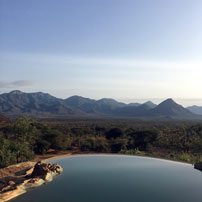
Not far from Sarara is Saruni’s newest camp – Saruni Rhino. Located on the banks of the dry Kauro Riverbed in the Sera Community Conservancy, the emphasis of the camp is to provide guests the opportunity to track wild black rhino on foot. The camp consists of only two bandas with a maximum of five guests and I was fortunate enough to be the only one in camp. I headed out with the guide into the nearby fenced rhino sanctuary area. We continued through the sanctuary until we met up with two of the Sera Conservancy rangers – these were young men from the local area that had been trained from scratch to monitor and protect the rhino. We used telemetry equipment to search for the approximate location of the rhino before leaving the vehicle and venturing in on foot. After walking for 30 to 40 minutes, we came across a silhouette in a far thicket. The guide then prompted me to sit and watch. We 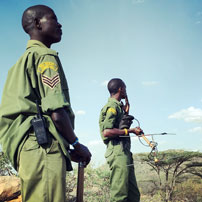 waited and waited, with patience being essential to gain a good sighting of the skittish creatures. Eventually they began to move, all four of them. My guide Sambara made sure we were downwind and we followed from a distance until we came to a clearing, we paused and sat and watched a magnificent female come to within about 30 metres of us – my adrenaline was definitely pumping as she looked up and noticed us, before turning and bolting into the thicket!
waited and waited, with patience being essential to gain a good sighting of the skittish creatures. Eventually they began to move, all four of them. My guide Sambara made sure we were downwind and we followed from a distance until we came to a clearing, we paused and sat and watched a magnificent female come to within about 30 metres of us – my adrenaline was definitely pumping as she looked up and noticed us, before turning and bolting into the thicket!
From the Sera Conservancy, I continued southwards towards the Kalama Conservancy and Saruni’s other property in the region – Saruni Samburu. Located high on a rocky outcrop, Saruni Samburu has breath-taking views across the Kalama Conservancy. In the 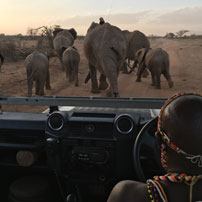 afternoon, my guide and I game drove through the conservancy and into the Samburu National Reserve (approx. 40 minute game drive). The game was good along the Ewaso Nyiro River and I saw plenty of elephant, lions and good general game including healthy numbers of Grevy’s Zebra. However, similar to Amboseli, being a National Park/Reserve you can see many vehicles with both self-drivers and private guide/drivers who drive in from the nearby Archer’s Post.
afternoon, my guide and I game drove through the conservancy and into the Samburu National Reserve (approx. 40 minute game drive). The game was good along the Ewaso Nyiro River and I saw plenty of elephant, lions and good general game including healthy numbers of Grevy’s Zebra. However, similar to Amboseli, being a National Park/Reserve you can see many vehicles with both self-drivers and private guide/drivers who drive in from the nearby Archer’s Post.
Early the next morning, I sat eating breakfast, out the corner of my eye I noticed something moving at the bottom of the rocky outcrop. After looking through my binoculars, I noticed five (yes five) cheetah by the dry waterhole – not a bad way to start the day! From here, I transferred to the nearby Kalama airstrip to connect with a charter flight into the Laikipia. One night was spent with Jamie Christian of Karisia Walking Safaris in their mobile camp – a great experience with excellent guiding. I then spent on night at El Karama, in central Laikipia before flying down to the Masai Mara.
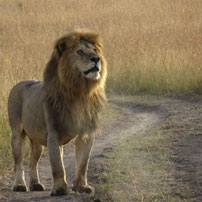
I was excited to return to the Masai Mara as I had seen on social media that the wildebeest herds had arrived, slightly earlier than usual. On my previous visit, I explored the conservancies bordering the main reserve. This time however, I covered as much of the National Reserve and Mara Triangle as possible, visiting many of the migration crossing points and generally learning the geography of the area. Despite not being quite at its peak, the vast numbers of wildebeest, zebra and other antelope was astonishing. On a morning drive from Sala’s Camp to Naibor, we saw seven fresh kills (without the cats) which shows just how easy life is for the predators at this time of year. Visiting the southern part of the National Reserve (around the Sand River) really was excellent at this time of year. The rolling plains were covered in prey and this of course attracted the predators. Surprisingly, I didn’t see a vast number of other vehicles (until you reach the crossing points, where vehicles tend to congregate), however, in the height of high season the vehicles the number of vehicles will rise significantly. If catching a glimpse of a crossing is a key priority, then it is definitely worth spending time in the Reserve for a few nights, before heading out to the conservancies for a more exclusive experience.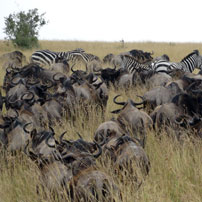
From the Mara, I flew on the direct Mombasa Air flight to Diani Beach/Ukunda. Leaving at 14h00 and arriving at 16h30 (approx.) it really is painless – you can be on safari in the morning and lying on the beach in the afternoon! My first night was spent in the Diani Beach area. This is a buzzy and vibrant destination busy with tourists, locals and the notorious ‘beach boys’. If you are looking for a more happening destination, where you can go out for dinner and enjoy different bars to explore etc. then Diani Beach is excellent.
In Diani, I carried out a number of inspections at some larger resort style properties before driving southwards to the Galu, Kinondo and Msambweni Beach areas. The further south from Diani I went, the quieter and more rural the setting. A personal highlight was staying at Kinondo Kwetu. The elegantly authentic beach lodge really feels like an extension of your safari with excellent levels of service, food and comfort with almost a ‘home from home’ feel. It is in a very peaceful location and if you wake up early enough, you can see the local fisherman heading out for the day.
This trip really demonstrated the vast safari options in Kenya. Of course the Masai Mara is the centre piece of a Kenyan safari, but combining it with one if not a number of the other regions I visited is really worthwhile for a variety of game viewing, landscapes and experiences.
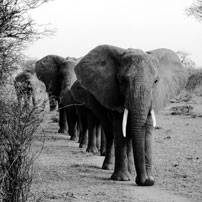
During Joe’s trip he stayed at: Crowne Plaza Nairobi Airport (formerly Lazizi Premiere), Tortlis Camp, Elewana Elsa’s Kopje, Sarara Camp, Saruni Rhino, Saruni Samburu, Karisia Walking Safaris, El Karama Eco Lodge, Sala’s Camp, Naibor Camp, Olonana, Diani Blue and Kinondo Kwetu.
Joe also site inspected: Cottar’s 1920s Camp, Sand River Camp, Little Naibor, 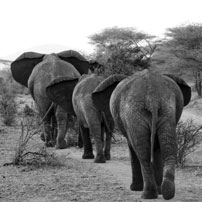 Naibor Wilderness, Governors Camp, Governors Il Moran, Little Governors, Angama Mara, Kilima Camp, Kichwa Tembo Tented Camp, Bateleur Camp, Water Lovers, Afrochic, Baobab Beach Resort, Pinewood Beach Resort and Spa, Msambweni Beach House & Private Villas, The Ocean Spa Lodge and Palacina Hotel.
Naibor Wilderness, Governors Camp, Governors Il Moran, Little Governors, Angama Mara, Kilima Camp, Kichwa Tembo Tented Camp, Bateleur Camp, Water Lovers, Afrochic, Baobab Beach Resort, Pinewood Beach Resort and Spa, Msambweni Beach House & Private Villas, The Ocean Spa Lodge and Palacina Hotel.

